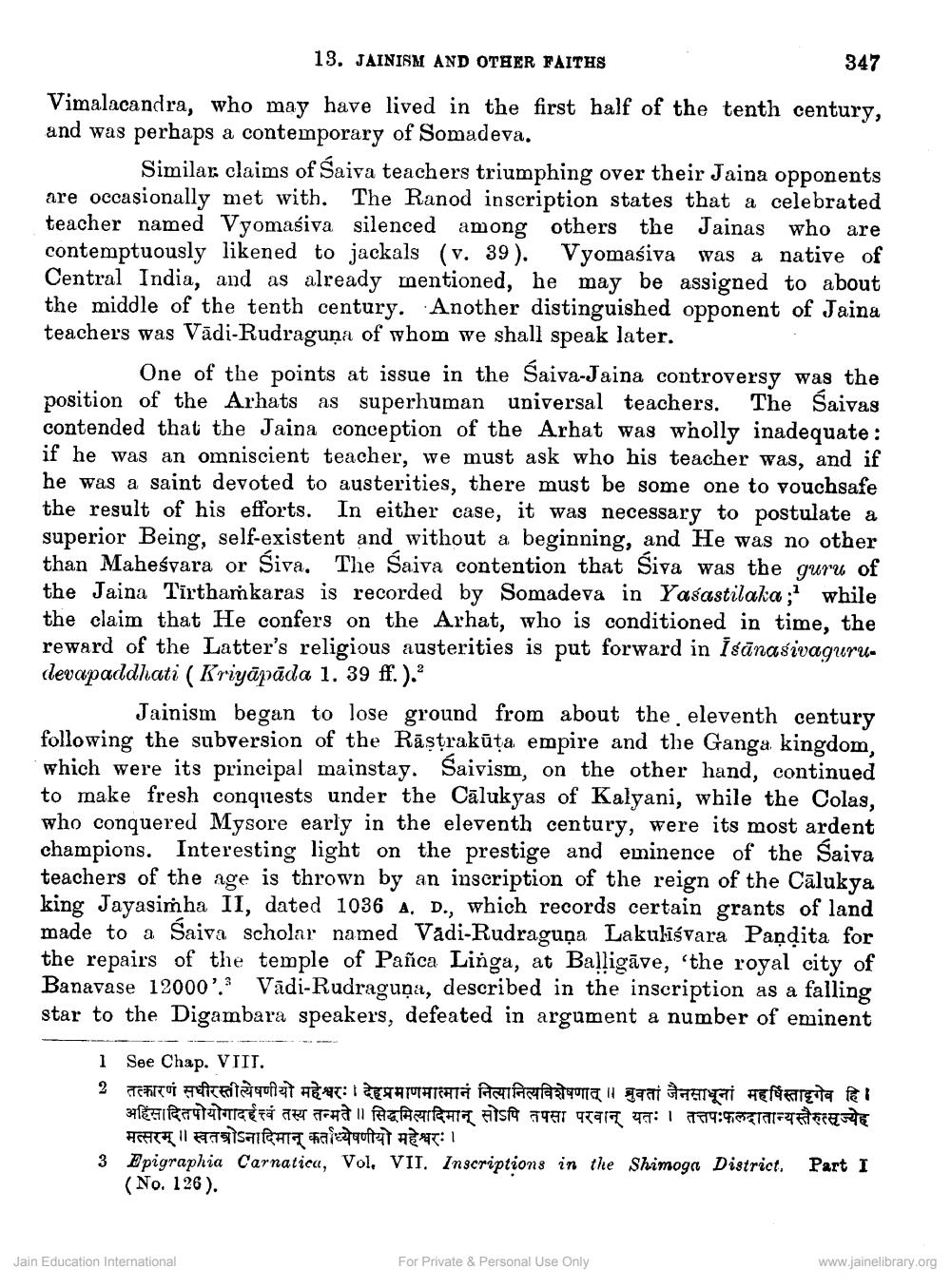________________
13. JAINISM AND OTHER FAITHS
Vimalacandra, who may have lived in the first half of the tenth century, and was perhaps a contemporary of Somadeva.
Similar claims of Saiva teachers triumphing over their Jaina opponents are occasionally met with. The Ranod inscription states that a celebrated teacher named Vyomasiva silenced among others the Jainas who are contemptuously likened to jackals (v. 39). Vyomasiva was a native of Central India, and as already mentioned, he may be assigned to about the middle of the tenth century. Another distinguished opponent of Jaina teachers was Vādi-Rudraguna of whom we shall speak later.
347
One of the points at issue in the Saiva-Jaina controversy was the position of the Arhats as superhuman universal teachers. The Saivas contended that the Jaina conception of the Arhat was wholly inadequate : if he was an omniscient teacher, we must ask who his teacher was, and if he was a saint devoted to austerities, there must be some one to vouchsafe the result of his efforts. In either case, it was necessary to postulate a superior Being, self-existent and without a beginning, and He was no other than Maheśvara or Śiva. The Saiva contention that Siva was the guru of the Jaina Tirthamkaras is recorded by Somadeva in Yasastilaka; while the claim that He confers on the Arhat, who is conditioned in time, the reward of the Latter's religious austerities is put forward in Isanasivagurudevapaddhati (Kriyāpāda 1. 39 ff.).
Jainism began to lose ground from about the eleventh century following the subversion of the Raṣṭrakūta empire and the Ganga kingdom, which were its principal mainstay. Śaivism, on the other hand, continued to make fresh conquests under the Calukyas of Kalyani, while the Colas, who conquered Mysore early in the eleventh century, were its most ardent champions. Interesting light on the prestige and eminence of the Saiva teachers of the age is thrown by an inscription of the reign of the Calukya king Jayasimha II, dated 1036 A. D., which records certain grants of land made to a Saiva scholar named Vadi-Rudraguna Lakulisvara Pandita for the repairs of the temple of Pañca Linga, at Balligave, 'the royal city of Banavase 12000'. Vadi-Rudraguna, described in the inscription as a falling star to the Digambara speakers, defeated in argument a number of eminent
1 See Chap. VIII.
2 तत्कारणं सधीरस्तीत्येषणीयो महेश्वरः । देहप्रमाणमात्मानं नित्यानित्यविशेषणात् ॥ भवतां जैनसाधूनां महर्षिस्तादृगेव हि । अहिंसादितपोयोगादर्हत्त्वं तस्य तन्मते ॥ सिद्धमित्यादिमान् सोऽपि तपसा परवान् यतः । तत्तपःफलदातान्यस्तैरुत्सृज्येह मत्सरम् ॥ स्वतत्रोऽनादिमान् कर्ताध्येषणीयो महेश्वरः ।
3 Epigraphia Carnatica, Vol. VII. Inscriptions in the Shimoga District. Part I (No. 126).
Jain Education International
For Private & Personal Use Only
www.jainelibrary.org




